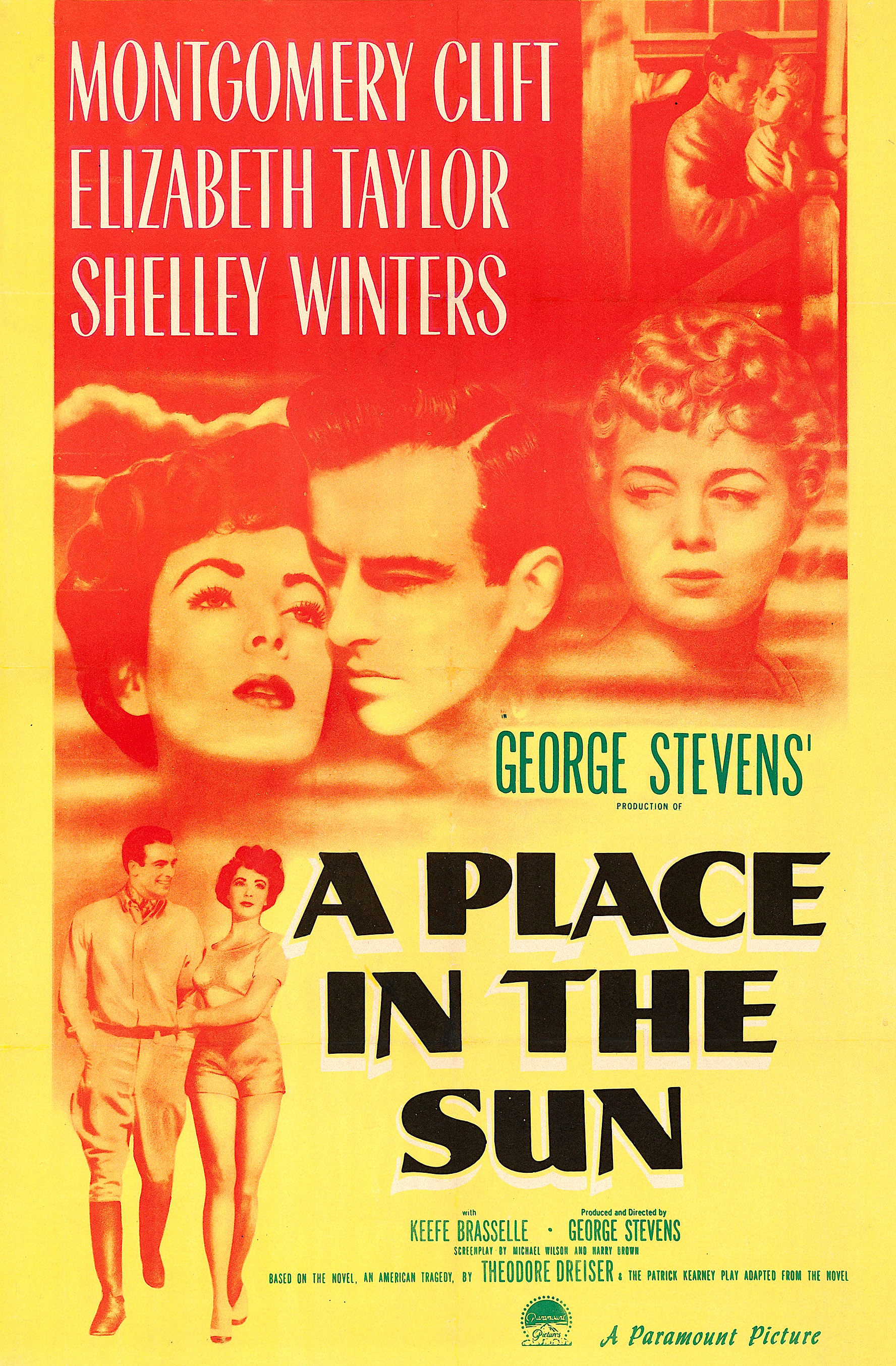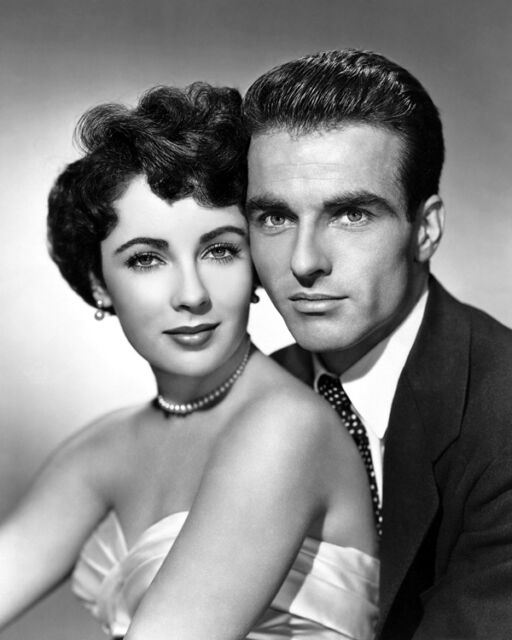We're watching all 17 of Montgomery Clift's films for his centennial. Here's Juan Carlos...


After starring in The Search, Red River, The Heiress, and The Big Lift, all but one of them either a critical or commercial success, Montgomery Clift reached an even great peak in 1951 with George Stevens’ A Place in the Sun. It was the adaptation of a novel and play, both called An American Tragedy, that were in turn inspired by the real-life murder of Grace Brown by Chester Gillette in 1906. The story, already made into a 1931 pre-Code drama as An American Tragedy, took on a life of its own in its 1951 form. A Place in the Sun's now classic tale of doomed romance and class divide proved a crucial success in the careers of all of its key players, winning six Oscars in a tight battle for Best Picture with An American in Paris.
Shelley Winters stripped herself of the bombshell packaging that the studio system had placed on her and in turn earned her first Academy Award nomination. For Elizabeth Taylor, the film was a key act in her transition from juvenile star to legendary adult star. Meanwhile, the film gave director George Stevens his first Oscar on his second nomination. For Clift, this film, coupled with Marlon Brando’s smolderingly threatening work in Elia Kazan’s A Streetcar Named Desire released the same year, put The Method into the mainstream leading to an inevitable shift in acting styles in American cinema...

Though he was picky about his projects, it now seems a no-brainer that Clift agreed to take part in this film. Some of the aspects of the film may seem dated (clunky expositions, endless dissolves, and the obvious male gaze on Taylor, then just 19 years old), but A Place in the Sun remains an example of exceptional Classic Hollywood filmmaking. It moves with brisk pacing, explores a surprisingly biting commentary of disillusionment towards the American dream, and offers up a group of rock solid performances to boot. Charlie Chaplin was even quoted calling the film “the greatest movie ever made about America”.
I could only imagine the zeitgeist of post-WWII United States, but looking back, it is quite brave for a film to depict the socio-economic frustration of those who dared to dream and hustle in the workforce to have a chance for a better life. Though the timing was unintentional the film was released during the Cold War, a time where capitalism and communism came to a head with the various iterations of geopolitical tensions for the years to come. The concept of labor and class struggle is the one of the core aspects of this ideological warfare.

Working hard to work your way up implies that hierarchies are inevitable and inescapable and our culture does its part in reinforcing that hegemony. However, that undermines the more honest truths of living in a capitalist society; Odds are stacked against some people in a preordained manner and A Place in the Sun understands that to some effect even if George benefits from nepotism on his way in.
With such a loaded socio-economic context at its core, enter brooding Montgomery Clift. Before the film’s release, he was marketed by studios as a sex symbol. However, his performance in A Place in the Sun has nary the makings of what you would expect from a touted sex symbol: glamor, sexuality, and even the Hollywood idea of star power. Instead, his work is reflective of the on-screen intensity that his craft as a method actor brought to the screen. His charms definitely come up in the film, but in the context of emotional manipulation that will then be shaded with the character’s questionable morals. It is really fascinating to see actors who use their beauty not as a fantasy for moviegoers or as a distraction from the story (heaven knows there are actors that actually look too good for the character they're playing) but as a way to further their characterization and even work against audience expectations.

For a quick synopsis, the film introduces us to George Eastman (Clift), a hitch-hiking young man on a quest to meet his rich uncle in the hopes of employment. Working at an entry-level job for his uncle's company leads him to Alice Tripp (Winters), a fellow worker on the assembly line. Despite workplace rules that forbid romance, the two begin dating. In the course of climbing the work ladder, George meets socialite Angela Vickers (Taylor). George makes advances with Angela and her social circle, but Alice’s unexpected pregnancy and demand to marry threatens his integration into this upper crust life. He then concocts a plan to murder Alice but hesistates. Alice does die but did George do it?
Known for being picky with his projects, it is quite understandable why Clift chose to delve deep on this character. It gives him a lot of opportunities to explore the dark side of a psyche without fully succumbing to villainy. In the process, he makes it an even more terrifying journey: Clift is tasked in dissecting the nuances of this troubled character and his place in this tragedy that is painted as the failure of the American dream.
Aside from the socio-economic status of the character another layer heightens the internal tension of his downward spiral. George comes from a religious family, with a mother (Anne Revere) who is actively participating in church activities. This element makes his moral dilemma even more striking. Not only is he experiencing this internal turmoil out of his own humanity, but there is an overarching code of religious rules that dictate his moral compass. In some ways, his culpability is even aggravated.
The first scene that really struck me with Clift's famed intensity is when he listens to the radio about an earlier drowning that happened on the lake. The news-on-the-radio-as-foreshadowing may be too on the nose but Clift transforms it from storytelling gimmick to a horrifying manifestation of what is going on inside of George's troubled head. In a moment of introspection, we see how a criminal is born. Clift gives us just enough to understand what he is thinking about it, but the specifics are left to our imagination. It is even more discomforting.
You see him in medium shot and then in a close-up, absorbing the flow of information and processing it. Physically, there is not much happening. He notices the news, focuses, starts to feel discomfort, and then as he closes the door, he just stands in place. His eyes and lack of movement suggest the busy chaos of what's inside his head. Clift needs no dialogue. The scene could even be stripped of its musical score and it would be just as chilling to witness.



This is a huge reason why his performance resonates to this very day -- it's all inner life that the audience is left to decode. Previous styles of acting would focus on the external to show what is happening, either with bigger gestures or stronger facial expressions. Clift and the actors that followed him brought film acting closer to "reality," and thus, they're more identifiable and their struggles hit uncomfortably close to home, too.
Despite coming from a new breed of actors, and his previous trouble with co-stars, his acting works beautifully in duets within A Place in the Sun. In fact, his internalized approach even helps activate the outsider feel of the character. With Elizabeth Taylor he is able to complicate the traditional Hollywood formula of pairing extremely gorgeous movie stars as automatic romantic drama. We do not know if George consistently sees Angela as his true love or as a ticket to the higher echelons of society. Or some of both, inconsistently. Regardless, their passion is felt and the on-screen chemistry contributes to the heartbreaking denouement of the film. No wonder that there were rumors that Clift and Taylor dated in real-life. It was perhaps mere speculation by fans or manufactured by the studios. We do know that in real life Clift and Taylor became life-long very close friends (this is the first of three pictures together). They're so perfectly matched onscreen that the tragedy of their dreamy romance feels even weightier.
On the other side of the triangle, Clift also finds a superb match in Shelley Winters. Her haunting descent to desperation brings true dramatic intensity in the build up to tragedy. Clift is even better in scenes with Winters. There is an uncomfortable shifting flow in their on-screen dynamic that creates an endless on-the-edge feeling. At one moment, Winters is more obviously dramatic while Clift maintains careful control. In another, Winters’ calm resolve will create a jarring effect when pitted against Clift’s extreme tension. Take their last scene together before her drowning.



In this moment, the battle inside of him is nearly palpable. Premeditation is definitely a factor, but up to the very last moment, George is experiencing a push-and-pull within himself. While the film's entire middle act commits to foreshadowing Alice’s doom, with the pacing rhythmically elevating the unbearable tension (the music really amps this up), Clift’s performance becomes even yet quieter. It is a surprising choice that marks how deep Clift went for A Place in the Sun.
The aftermath of Alice’s death marks a noticeable shift in Clift’s performance, but one that he never exaggerated. The cautiousness brought by trauma is carefully integrated in the succeeding scenes. His smile is haunted by wider eyes, almost always surveying the surroundings, as if someone knows what he has done... or thought of doing. A sense of growing helplessness becomes evident in the performance; a combination of regret and hoping to getting away with murder. When the film turns into a courtroom drama, Clift maintains careful crafting of his character despite the theatrics of the proceedings. During the final stretch of the film, Clift portrays a more haunted surrender as George awaits execution.
Maybe it was remorse and admission of guilt. Maybe it was the sight of the American dream slowly falling away. There are so many things going on in his mind. By the end of the film, we know this is not the same George that merely dreaming of a better life. Clift embodies the ‘dead man walking’ quality of a man condemned with a restraint that is remarkable even by today’s acting standards. It is noted that director George Stevens wanted him to “do something amazing” with his final walk, but Clift chooses to go with a more naturalistic, depressed facial expression. It is this loyalty to the truth of the character that makes Clift such a remarkable actor. The introspective quality of his work in this film has certainly aged it way better than many of his contemporaries performances.

Of course, no performance exists in a bubble. Clift also benefits from overall superb filmmaking around him. A Place in the Sun maximizes Clint’s strengths as an actor of quiet forces affording him several lengthy moments of just responding to what he hears or sees. We are also given multiple closeups showing either innocent consideration or outright calculation. Even in wide shots, his intensity is easily felt, perfectly captured, and expertly modulated. His interaction with his costumes is also interesting. Whether wearing a leather jacket (a symbol of the era’s hypermasculinity) or a formal attire (appropriating himself in the upper class) he betrays himself with slouched posture, an indication of his lack of confidence.
A Place in the Sun remains to be one of the most important films of the 1950s, an elegantly crafted romantic tragedy that was the jumpstart for many of the key players’ future acclaim. While Clift lost the Oscar his sensitivity, intensity, and introspective qualities have helped the film and performance age far better than many other lauded films and performances of the era.
